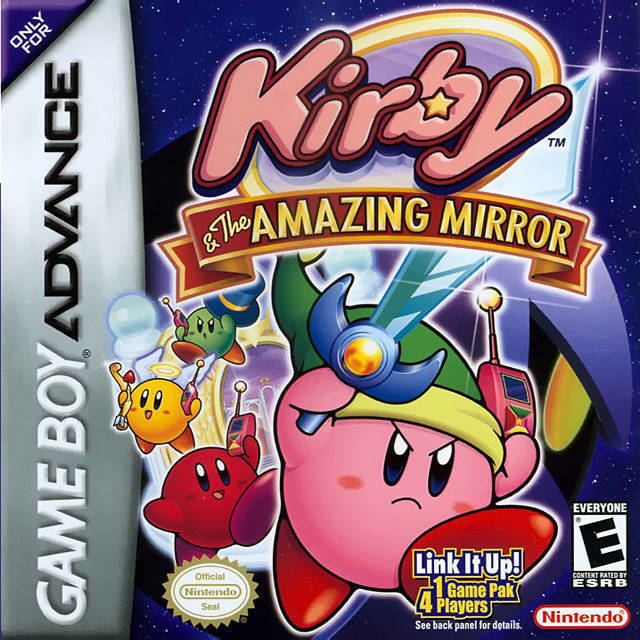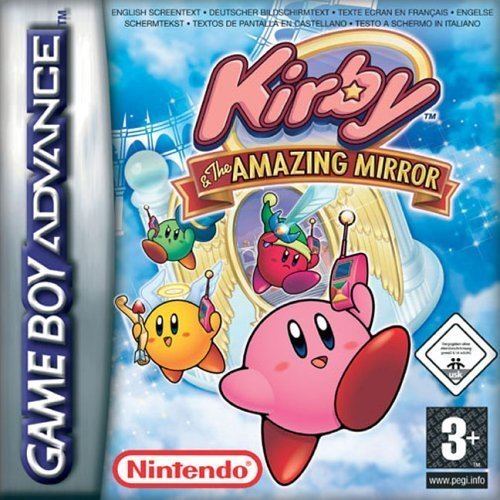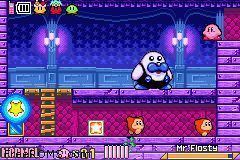9 /10 1 Votes9
Director(s) Tomoaki Fukui | 9/10 Games Lol Initial release date 15 April 2004 | |||||||||||||||||||||||||||||||||
 | ||||||||||||||||||||||||||||||||||
Producer(s) Yasushi AdachiMasayoshi TanimuraShigeru MiyamotoKenji Miki Composer(s) Hironobu InagakiAtsuyoshi Isemura Mode(s) Single-player, multiplayer Similar | ||||||||||||||||||||||||||||||||||
Kirby & the Amazing Mirror, known in Japan as Hoshi no Kirby: Kagami no Daimeikyū (星のカービィ 鏡の大迷宮, Hoshi no Kābī Kagami no Daimeikyū, lit. "Kirby of the Stars: The Great Mirror Labyrinth"), is a Kirby video game released in 2004 for the Game Boy Advance. It is the last Kirby game for the Game Boy Advance. Additionally, it was the only Kirby title where King Dedede doesn't make an appearance until Kirby and the Rainbow Curse, where he only appears when his Amiibo is scanned. Kirby & the Amazing Mirror is also an adventure-based game, rather than a linear side-scroller. This game bears similarities to The Legend of Zelda: Four Swords also published by Nintendo and released around the same time. Both are multiplayer adventure games that use the concept of the main character being split into four color coded individuals and having to work together to solve puzzles. The game was re-released in Europe for Club Nintendo members only.
Contents

Plot

There is a Mirror World that exists in the skies of Dream Land. It is a world where any wish reflected in the mirror will come true. However, one day it only copies evil minds, and rapidly changes into a world of evil. Meta Knight notices this, and flies up to save the Mirror World.
Meanwhile, Kirby is taking a walk when Dark Meta Knight appears. Before Kirby can react, Dark Meta Knight slices Kirby in four and Kirby becomes four different colored "Kirbys". They chase after Dark Meta Knight on a Warp Star and enter the Mirror World.
The two Meta Knights fought each other until the real Meta Knight is defeated. He is then knocked into the mirror, which is then cut into eight fragments by Dark Meta Knight (which are then scattered across the Mirror World), so Kirby must save Meta Knight and the Mirror World. After collecting all eight mirror fragments, Kirby enters the Mirror World and battles Dark Meta Knight. After defeating him, a vortex appears and sucks Kirby in, who is given Meta Knight's sword. Kirby then proceeds to fight Dark Mind, the true mastermind of the Mirror World's corruption, multiple times. Upon defeat, the Mirror World is saved, and Shadow Kirby(the Mirror World counterpart of Kirby who is believed to be an enemy, now ally) waves his goodbyes to the 4 Kirbys as they all exit the Mirror World via mirror door.
Gameplay
Unlike other Kirby games, Kirby & the Amazing Mirror features a maze layout, and is traversed in a style similar to the Metroid and Castlevania games. The game map branches out in several directions and, providing Kirby has the proper power at his disposal, he is able to go anywhere in almost any order, excluding the final sequence. If the player gains access to all mirrors (excluding the one the player is collecting shards for), they will be able to access a new mirror full of Copy Pedestals for their use.
The player explores the worlds, solving puzzles, defeating enemies, and collecting items. Occasionally, a sub-boss will be encountered, at which point the screen will lock into place until the boss is defeated. Swallowing a sub-boss after defeat usually grants a rare or exclusive copy ability. At the end of worlds 2-9 is a boss which the player must defeat to place another shard in the broken mirror in the Mirror Room. Before each boss is an antechamber where there is no music, for dramatic effect. The player respawns there and there are usually items hidden around it for healing before the fight as well as copy pedestals. The player will also occasionally encounter "rest areas" of sorts, where the music reverts to the music from the Mirror Room. There is usually an item and a copy pedestal or two in these areas as well. Some rest areas are part of a system linking back to the Mirror Room, and can be connected via giant buttons that are usually in the room itself, but are occasionally somewhere else in the world.
The player can collect various items to improve in-game performance, such as extra health points and lives, food to replenish health, and batteries for the Cellphone. The game also features two other collectibles: music sheets, which act as a sound test mode once the music player item is found, and spray paint, which can be used to recolor the player's Kirby. Both can be accessed from the main menu. There are also three minigames accessible from the menu, which support single player and multiplayer:
The game also features multiplayer, and the player can call other players or CPU-controlled Kirbys to the location with an in-game cell phone. The three other Kirbys are CPUs by default, but connecting to another GBA (which must also have an "Amazing Mirror" cartridge in it) allows for co-op multiplayer for enhanced teamwork and faster completion. There are several new powers in The Amazing Mirror, such as Cupid (called Angel in the Japanese version), which allows Kirby to fly around with wings and a halo and fire arrows; Missile, which turns Kirby into a missile that can be guided in any direction and will explode on contact with a wall or an enemy or when the B button is hit; and Smash, which gives Kirby the abilities he had in Super Smash Bros. Melee. Also, in this version, Kirby's ability to inhale various things has been expanded upon- now able to move or inhale larger objects by holding down the button until his mouth expands, increasing his inhaling power.
Worlds
The game features nine worlds, each with an alliterated name, excluding the final boss sequence.
Development
The game is a collaborative development effort between Flagship, Dimps and HAL Laboratory. Capcom's subsidiary Flagship was responsible for the main planning. Dimps was in charge of programming, design and sound, while HAL Laboratory provided artwork and debugging services. The composers are from Arika, but some tracks were reserved from Kirby: Nightmare in Dreamland.
Virtual Console
On August 1, 2011, Nintendo announced that Kirby & the Amazing Mirror would be available to limited Nintendo 3DS owners via Virtual Console, along with nine other Game Boy Advance games that were announced; it was released on December 16, 2011 (GMT), to join the upcoming Nintendo 3DS price-cut and the Ambassador program starting August 11, 2011. This offer is available in all territories and only to those who became eligible in the Ambassador program (by accessing the Nintendo eShop before the date of the price-cut). Nintendo currently has no plans to release this game, or any other Game Boy Advance game, to the general public in paid form on the 3DS.
The game was also released on the Wii U Virtual Console on April 3, 2014 in Japan and April 10, 2014 in North America and Europe.
Reception
The Amazing Mirror received "favorable" reviews according to the review aggregation website Metacritic. In Japan, Famitsu gave it a score of one nine, one ten, one nine, and one eight for a total of 36 out of 40.
IGN commented on the level design, stating, "It's discovering the hidden pathways that's the real challenge." GameSpot called the layout "daunting," but commented on the map feature. The graphics and sound were referred to as cute, though not amazing.
